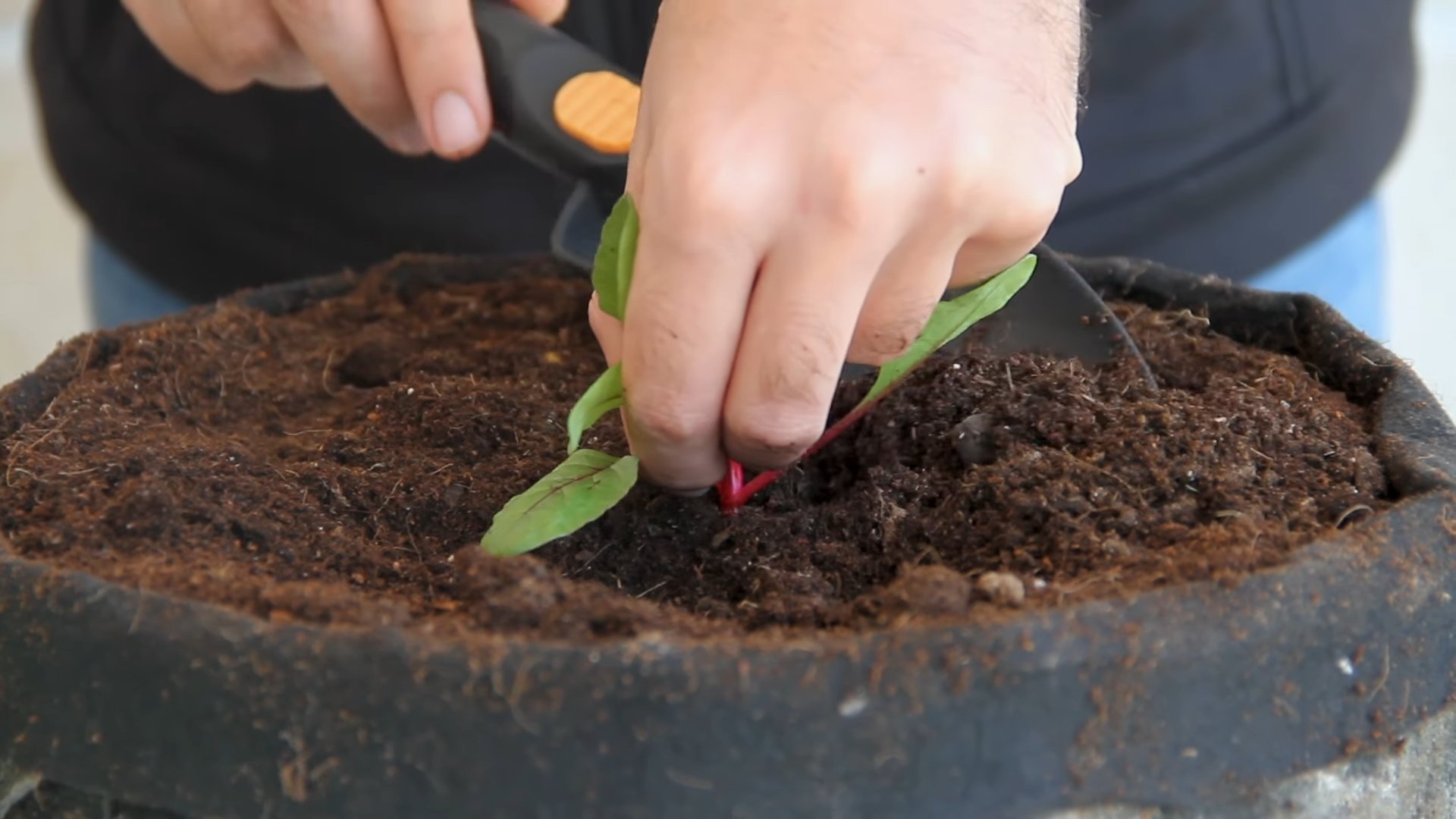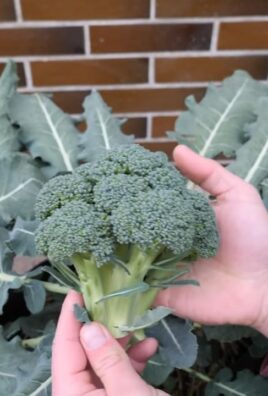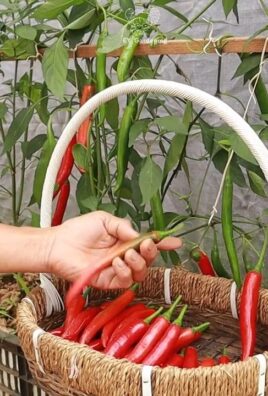Growing Beets at Home can seem intimidating, but trust me, it’s easier than you think! Have you ever dreamt of pulling vibrant, earthy beets straight from your own backyard? Imagine the satisfaction of serving a salad with ingredients you nurtured from seed to table. This isn’t just about food; it’s about connecting with nature and enjoying the freshest flavors imaginable.
Beets have a rich history, dating back to ancient times when their leafy greens were prized more than the root itself. The Romans were big fans, and over centuries, selective breeding transformed the humble beet into the sweet, colorful vegetable we know and love today. From borscht in Eastern Europe to roasted beet salads worldwide, this root vegetable has truly made its mark.
But why bother growing beets at home when you can buy them at the store? Well, for starters, homegrown beets taste infinitely better! They’re fresher, sweeter, and haven’t traveled miles in a truck. Plus, you have complete control over what goes into them – no pesticides or mystery ingredients. More importantly, in today’s world, knowing how to grow your own food is becoming increasingly valuable. It’s a sustainable skill that empowers you to be more self-sufficient and enjoy the simple pleasures of life. So, let’s dive into some easy DIY tricks and hacks that will have you harvesting a bumper crop of beets in no time!

Growing Beets at Home: A Beginner’s Guide
Okay, so you want to grow beets! That’s fantastic! Beets are not only delicious and nutritious, but they’re also relatively easy to grow, even for beginners. I’ve had great success with them in my own garden, and I’m excited to share my tips and tricks with you. Let’s dive in!
Choosing Your Beet Variety
First things first, let’s talk about beet varieties. There are tons of options out there, each with its own unique characteristics. Here are a few popular choices:
* Detroit Dark Red: This is a classic, reliable variety known for its deep red color and sweet flavor. It’s a great all-around beet for roasting, pickling, or using in salads.
* Chioggia: If you’re looking for something a little different, Chioggia beets are a fun choice. They have beautiful red and white concentric rings inside, making them a visually stunning addition to any dish.
* Golden Beet: As the name suggests, these beets have a vibrant golden color. They’re slightly milder in flavor than red beets and won’t stain your hands or clothes.
* Cylindra: These beets are long and cylindrical, making them perfect for slicing and canning. They also tend to mature a bit faster than other varieties.
I personally love growing a mix of Detroit Dark Red and Chioggia for variety. Experiment and see which ones you like best!
Preparing Your Garden Bed
Beets need a sunny spot with well-drained soil. Here’s how to get your garden bed ready:
* Sunlight: Beets need at least 6 hours of sunlight per day. Choose a location in your garden that gets plenty of sunshine.
* Soil: Beets prefer loose, fertile soil with a pH between 6.0 and 7.0. If your soil is heavy clay or sandy, amend it with compost or other organic matter to improve drainage and fertility.
* Remove Rocks and Debris: Beets need room to grow, so remove any rocks, sticks, or other debris from the planting area.
* Loosen the Soil: Use a garden fork or tiller to loosen the soil to a depth of at least 12 inches. This will make it easier for the beet roots to grow.
* Add Compost: Mix in a generous amount of compost or well-rotted manure to enrich the soil. This will provide your beets with the nutrients they need to thrive.
* Level the Surface: Rake the surface of the soil to create a smooth, even planting bed.
Planting Your Beet Seeds
Now for the fun part – planting!
1. Timing is Key: Beets are a cool-season crop, so the best time to plant them is in early spring or late summer. In the spring, plant your seeds 2-4 weeks before the last expected frost. For a fall harvest, plant them 6-8 weeks before the first expected frost. I usually aim for late April/early May for my spring planting.
2. Direct Sowing: Beets are best direct-sown, meaning you plant the seeds directly in the garden. They don’t transplant well.
3. Spacing: Sow the seeds about 1 inch deep and 1-2 inches apart in rows that are 12-18 inches apart.
4. Cover and Water: Gently cover the seeds with soil and water thoroughly. Keep the soil consistently moist until the seeds germinate.
5. Thinning: Beet “seeds” are actually clusters of seeds, so you’ll need to thin the seedlings once they emerge. When the seedlings are about 2-3 inches tall, thin them to 3-4 inches apart. This will give the beets enough room to develop properly. Don’t throw away the thinnings! You can eat the beet greens in salads or saute them.
Caring for Your Beet Plants
Once your beet seedlings are established, here’s how to keep them happy and healthy:
* Watering: Beets need consistent moisture, especially during hot, dry weather. Water deeply whenever the top inch of soil feels dry.
* Weeding: Keep the garden bed free of weeds, which can compete with the beets for nutrients and water. Hand-pull weeds carefully to avoid disturbing the beet roots.
* Fertilizing: Beets are heavy feeders, so you may need to fertilize them during the growing season. Use a balanced fertilizer or side-dress with compost every few weeks. I like to use a liquid seaweed fertilizer for an extra boost.
* Mulching: Apply a layer of mulch around the beet plants to help retain moisture, suppress weeds, and regulate soil temperature. Straw, wood chips, or shredded leaves are all good options.
Dealing with Pests and Diseases
Beets are generally resistant to pests and diseases, but here are a few things to watch out for:
* Leaf Miners: These tiny insects tunnel through the leaves, leaving unsightly trails. You can control leaf miners by covering your plants with row covers or by spraying them with insecticidal soap.
* Flea Beetles: These small, jumping beetles can chew holes in the leaves of your beet plants. You can control flea beetles by using row covers, diatomaceous earth, or insecticidal soap.
* Cercospora Leaf Spot: This fungal disease causes small, circular spots on the leaves. To prevent Cercospora leaf spot, avoid overhead watering and provide good air circulation. If you see signs of the disease, remove infected leaves and spray the plants with a fungicide.
Harvesting Your Beets
The moment you’ve been waiting for!
1. Timing: Beets are typically ready to harvest 50-70 days after planting, depending on the variety. You can harvest them at any size, but they’re usually best when they’re about 2-3 inches in diameter.
2. Checking for Readiness: Gently brush away the soil around the beet to check its size. If it’s big enough, you can harvest it.
3. Harvesting Technique: Loosen the soil around the beet with a garden fork or trowel. Gently pull the beet out of the ground, holding it by the base of the leaves.
4. Trimming: Cut off the beet greens, leaving about 1-2 inches of stem attached to the beet. You can eat the beet greens – they’re delicious!
5. Cleaning: Brush off any excess soil from the beets. Don’t wash them until you’re ready to use them, as washing can shorten their storage life.
Storing Your Beets
To keep your beets fresh for as long as possible, store them properly:
* Remove Greens: As mentioned above, remove the beet greens before storing the beets.
* Don’t Wash: Avoid washing the beets until you’re ready to use them.
* Storage Conditions: Store the beets in a cool, dark, and humid place, such as a refrigerator or root cellar.
* Storage Method: Place the beets in a plastic bag or container with a damp paper towel to help maintain humidity.
* Storage Life: Properly stored beets can last for several months.
Using Your Harvest
Now that you’ve harvested your beets, it’s time to enjoy them! Here are a few ideas:
* Roasting: Roasting beets brings out their natural sweetness. Simply toss them with olive oil, salt, and pepper, and roast them in the oven until tender.
* Boiling: Boiling beets is another easy way to cook them. Just boil them until they’re tender, then peel and slice them.
* Pickling: Pickled beets are a classic condiment that adds a tangy flavor to salads and sandwiches.
* Salads: Beets are a delicious addition to salads. You can use them raw, roasted, or pickled.
* Beet Greens: Don’t forget about the beet greens! They can be used in salads, sauteed, or added to soups and stews.
Troubleshooting
Even with the best planning, sometimes things don’t go exactly as expected. Here are a few common beet-growing problems and how to address them:
* Poor Germination: If your beet seeds aren’t germinating, make sure the soil is consistently moist and that the soil temperature is warm enough (around 50-75°F). You can also try soaking the seeds in water for 24 hours before planting.
* Slow Growth: If your beet plants are growing slowly, they may not be getting enough sunlight or nutrients. Make sure they’re in a sunny location and fertilize them regularly.
* Bolting: Bolting is when a plant prematurely produces flowers and seeds. This can happen if the weather is too hot or if the plants are stressed. To prevent bolting, choose bolt-resistant varieties and provide consistent watering.
* Fork

Conclusion
So, there you have it! Growing beets at home is not only achievable, but it’s also a deeply rewarding experience that connects you with the food you eat in a tangible way. Forget those bland, pre-packaged beets from the grocery store. Imagine the vibrant colors, the earthy sweetness, and the satisfying crunch of beets you’ve nurtured from seed to table. This isn’t just about saving a few dollars; it’s about embracing a more sustainable lifestyle and enjoying the unparalleled flavor of freshly harvested produce.
Why is this DIY trick a must-try? Because it empowers you to control every aspect of your beet cultivation, from the soil composition to the watering schedule. You can choose organic methods, ensuring your beets are free from harmful pesticides and chemicals. Plus, the sheer joy of watching those tiny seeds sprout and transform into plump, ruby-red roots is an experience that’s hard to beat (pun intended!).
But the benefits don’t stop there. Growing your own beets opens up a world of culinary possibilities. Experiment with different varieties, from the classic Detroit Dark Red to the golden Yellow Detroit or the candy-striped Chioggia. Each variety offers a unique flavor profile and visual appeal, adding excitement to your meals.
Consider these variations to elevate your beet-growing game:
* Succession Planting: Plant new seeds every few weeks to ensure a continuous harvest throughout the growing season.
* Companion Planting: Plant beets alongside other vegetables like onions, garlic, or lettuce to deter pests and improve soil health.
* Container Gardening: If you’re short on space, grow beets in containers on your patio or balcony. Just make sure the containers are deep enough to accommodate the root growth.
* Beet Greens: Don’t forget about the beet greens! They’re packed with nutrients and can be used in salads, stir-fries, or soups. Treat them like spinach or chard.
* Soil Amendments: Incorporate compost or well-rotted manure into the soil before planting to provide essential nutrients and improve drainage.
We understand that gardening can sometimes feel intimidating, especially for beginners. But growing beets is surprisingly straightforward, and the rewards are well worth the effort. With a little planning and attention, you can enjoy a bountiful harvest of delicious, homegrown beets.
We wholeheartedly encourage you to give this DIY trick a try. Start small, learn as you go, and don’t be afraid to experiment. The satisfaction of harvesting your own beets is an experience you won’t soon forget.
And most importantly, we want to hear about your experiences! Share your photos, tips, and stories in the comments section below. Let’s create a community of beet-growing enthusiasts and inspire others to embrace the joys of homegrown produce. What varieties did you try? What challenges did you face? What successes did you celebrate? Your feedback is invaluable and will help us improve this guide for future gardeners. So, get your hands dirty, plant those seeds, and let the beet-growing adventure begin! Let us know how your growing beets journey goes!
Frequently Asked Questions (FAQ)
What is the best time of year to plant beets?
The ideal time to plant beets depends on your climate. In general, beets are a cool-season crop, so they thrive in spring and fall. For a spring crop, sow seeds 2-3 weeks before the last expected frost. For a fall crop, sow seeds 6-8 weeks before the first expected frost. In warmer climates, you can plant beets throughout the winter.
How much sunlight do beets need?
Beets need at least 6 hours of sunlight per day to thrive. Choose a planting location that receives full sun for optimal growth. If you’re growing beets in containers, make sure to place them in a sunny spot.
What type of soil is best for growing beets?
Beets prefer well-drained, loose soil that is rich in organic matter. The ideal soil pH is between 6.0 and 7.0. Before planting, amend the soil with compost or well-rotted manure to improve drainage and fertility. Avoid soils that are heavy or compacted, as they can hinder root development.
How often should I water my beets?
Beets need consistent moisture to grow properly. Water deeply and regularly, especially during dry periods. Aim to keep the soil consistently moist but not waterlogged. A good rule of thumb is to water when the top inch of soil feels dry to the touch. Mulching around the plants can help retain moisture and suppress weeds.
How long does it take for beets to mature?
Beets typically take 50-70 days to mature, depending on the variety. You can harvest beets when the roots are about 2-3 inches in diameter. Check the seed packet for specific maturity times for the variety you are growing. You can also harvest the beet greens at any time, but be careful not to remove too many leaves at once, as this can stunt the growth of the roots.
What are some common pests and diseases that affect beets?
Some common pests that affect beets include aphids, flea beetles, and leaf miners. Diseases that can affect beets include leaf spot, damping-off, and powdery mildew. To prevent pests and diseases, practice good garden hygiene, such as removing weeds and debris, and rotate your crops regularly. You can also use organic pest control methods, such as insecticidal soap or neem oil, to control pests.
How do I harvest beets?
To harvest beets, gently loosen the soil around the roots with a garden fork or trowel. Then, grasp the beet greens near the base of the plant and pull the beet out of the ground. If the beets are difficult to pull, you may need to loosen the soil further. Once you have harvested the beets, remove the greens, leaving about an inch of stem attached. Store the beets in a cool, dry place.
Can I eat the beet greens?
Yes, beet greens are edible and nutritious. They can be used in salads, stir-fries, soups, or any other dish where you would use spinach or chard. Beet greens are a good source of vitamins A and C, as well as iron and fiber.
How do I store beets?
To store beets, remove the greens, leaving about an inch of stem attached. Gently brush off any excess soil, but do not wash the beets. Store the beets in a cool, dry place, such as a root cellar or refrigerator. Beets can be stored for several months if stored properly.
What are some creative ways to use homegrown beets?
Homegrown beets can be used in a variety of dishes. You can roast them, boil them, pickle them, or grate them into salads. Beet greens can be used in salads, stir-fries, or soups. Beets can also be used to make beet juice, which is a healthy and refreshing drink. Consider making beet hummus, beet and goat cheese salad, or even a beet chocolate cake for a unique and delicious treat. The possibilities are endless!





Leave a Comment